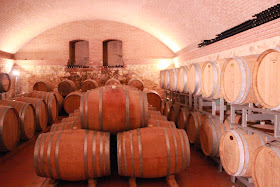The journey continues with my last day
of winery visits within the Valpolicella wine region in celebration
of the Anteprima Amarone event in Verona. If you have been following my journey it started with a tour of Bolla and a dinner with the winemaker as well as another full day of winery tours. My 3rd day I
toured:
- San Cassiano
- Corte Figaretto
- Massimago
- Corte Sant'Alda
San Cassiano
Mirko Sella was not only a wonderful and host, but also the owner and
winemaker of San Cassiano located on 14 hectacres (35 acres) at about
380 meters (1250 feet) in Mezzane di Sotto in the Mezzane Valley,
which is a comune in the province of Verona. Mirko started producing
wine in 2001 along with his father from 2 hills on the estate mostly
consisting of limestone. Their production is about 60-70k bottles.
Mirko's style of winemaking is to make the wine as natural as
possible using less and less chemicals over time at about 50% less
currently. Many of the wines we tasted here were great, but my
favorite was the 2009 San Cassiano Valpolicella Superiore. It's aged
2 years in oak with a hint of vanilla along with some spiciness and
darker fruits. In additional to wine Mirko also produces olive oil
from their land with the grignano olive variety on about 8
hectacres. The San Cassiano winery is a perfect example of why I am
proven time and time again of my love for smaller to medium sized
wineries for not only the quality wines that they are capable of
producing, but the overall experience you get when visiting them.
 |
| Mirko Sella |
Corte Figaretto
Owner and winemaker Mauro Bustaggi of winery Corte
Figaretto had always made wine for the social cantina in the
past, but stopped in 2002 in wanting to produce his own wines. In
2004 he built his current wine cellar and has been producing wines
since making about 75,000 bottles annually on 8 hectacres of land in
whats known as the “cru” of the valpolicella wine region in the
land of the Valpantena. For Mauro it's important to “respect and
maintain the history of the grape”. Inside of the wine cellar are
holes in the floors where the grapes are brought into to avoid the
grapes breaking from gravity and are vinified into stainless steel.
The Corte Figaretto wines were enjoyed over a wonderful multi-course
luncheon served by Mauro's father.
 |
| Mauro demonstrating hole for emptying grapes into fermentation tanks |
 |
| Crates for drying Amarone grapes during harvest |
 |
| Mauro Bustaggi |
Massimago
Also located in the Mezzane Valley is the winery, Massimago.
In 1883 the Cracco family went to the countryside during WWII and
settled down where Massimago is currently located. The vines of the
estate were planted in the 30's and 40's, but were never used until
the winery was opened in 2003 by Camilla Rossi Chauvenet whom had
studied egronomy. The Massimago winery consists of 20 hectacres (49
acres). With limited space for wine production they keep the best
resulting in 40,000 bottles and the rest of the grapes are sold off
with 80% of the wine being exported. The youngest vines of the
winery are 10 years old. Some interesting and different wines that I
experienced at other wineries including the Massimago Garganega
Milleduecento that is aged 5 months in oak, which is not quite a
soave since its close but not exactly in the soave zone. Also, I
sampled their Massimago Rosae Saignee, a rose' made of the
valpolicella blend with 65% corvina, 20% corvinone and 15%
rondinella.
Corte Sant'Alda
Last winery of the day, Corte
Sant' Alda, and a great way to end as well. Marinella Camerani,
the owner and winemaker, was welcoming and greeted us cheerfully upon
arrival. Her father bought the property in Mezzane di Sotto in the
Mezzane Valley in the 70's as an investment, but enjoyed the wine for
himself and amongst friends as a hobby. Deciding to give it a hand
at winemaking, in the 80's Marinella took over winemaking, revamping
the vineyards, building the wine cellar and furthering her knowledge
of winemaking from others. During renovations Roman artifacts were
founds as an ancient Roman road had existed where the property
resided. Corte Sant'Alda also was the first guyot in the valley 26
years ago. The Corte Sant'Alda estate consists of 19 hectacres (46
acres) of land in addition to 20 hectacres of olives and cherry
trees. Marinella also built a new cellar in 2001. She enjoys
experimenting with cement and amphora with rose'. Marinella's
favorite wine in the world in Burgundy pinot noir and wants to
imitate this with valpolicella. I enjoyed many of the wines during
the tasting, but my favorite was the 2010 Corte Sant'Alda Mithas
Valpolicella Superiore, which is actually only produced in the best
vintage. It's aged two years in oak and you get that hint of oak and
vanilla on the palate with some nice spices and ripe, juicy fruit.
 |
| Cement tanks at Corte Sant'Alda |
 |
| Clay amphora |
 |
| Marinella Camerani |
Overall I had wonderful winery visits
while traveling throughout the Valpolicella. Of course I have
preferences of one winery over another and the wines produced, but
one of the reasons why I love Italian wine is my personal connection
to the land and the country itself and all the wonderful winemakers I
have met over the years. I appreciate every winery's history,
traditions and style of winemaking and enjoy exploring the terroir of
each particular region and the results produced in the final product.
My neverending journey and I'm loving every minute of it. Stay
tuned to the final event of the Anteprima Amarone event to be shared
next week.








No comments:
Post a Comment